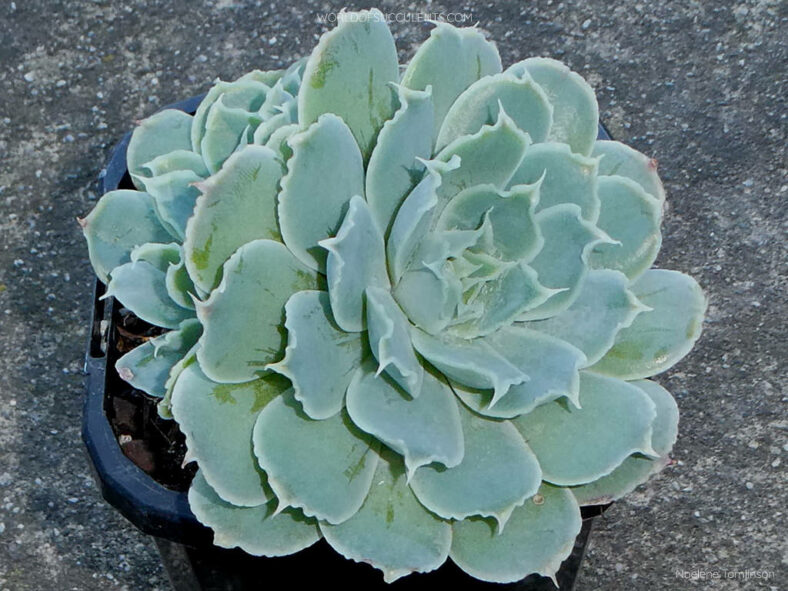Echeveria simulans is a very variable species. The plants sold as Echeveria simulans 'Laguna Sanchez' and Echeveria simulans 'Ascension' are not cultivars; instead, they are forms of Echeveria simulans discovered in Laguna Sanchez, Nuevo León, and Ascensión, Chihuahua, in Mexico.
Scientific Name
Echeveria simulans Rose
Synonym(s)
Echeveria elegans var. simulans
Scientific Classification
Family: Crassulaceae
Subfamily: Sempervivoideae
Tribe: Sedeae
Genus: Echeveria
Etymology
The specific epithet "simulans" (pronounced "sim-YOO-lans") means "imitating, copying" and refers to this species' similarity to Echeveria elegans.
Origin
Echeveria simulans is native to Mexico. It occurs in Nuevo León, San Luis Potosí, Aguascalientes, Guanajuato, Querétaro, and Hidalgo.
Description
Echeveria simulans, also known as Echeveria elegans var. simulans, is a small succulent that typically forms a solitary rosette of glaucous leaves, often purplish towards the tips. The stemless rosettes can reach a diameter of 5.6 inches (14 cm) and may develop into a small clump with age. The leaves are spoon-shaped, wedge-shaped, or inversely egg-shaped, with pointed tips and flat or slightly crisped margins. They can measure up to 2.4 inches (6 cm) long and 1.4 inches (3.5 cm) wide.
In spring, Echeveria simulans produces bell-shaped flowers on erect or arching stalks with 7 to 9 bracts. The flower stalk can grow up to 14 inches (35 cm) long. The flowers have unequal, pinkish sepals and a corolla with a rose-colored base and yellow tips on the lobes and inner surface. They can reach up to 0.5 inches (1.2 cm) in length and 0.3 inches (0.7 cm) in diameter.
Echeveria simulans is very similar to Echeveria elegans, but it has flatter rosettes and typically spreading leaves that are never reflexed and thinner, especially in the upper half. Additionally, this species has a narrower corolla.

How to Grow and Care for Echeveria simulans
Light: Echeveria simulans requires full sun to partial shade for optimal growth. Therefore, place it near the brightest window in your home. In addition, if you are moving the plant outside in spring, do it gradually and avoid exposure to intense afternoon sun.
Soil: Having soil that drains quickly is most important for growing a healthy succulent. While many growers prefer to create their own soil mix, commercial soil designed for succulents will work fine.
Temperature: High temperatures are not a problem as long as there is plenty of fresh air, but Echeveria simulans is a tender succulent and must be brought indoors if there is a risk of freezing temperatures. It grows best in USDA Plant Hardiness Zones 10a to 11b, with average minimum winter temperatures ranging from 30°F to 50°F (-1.1°C to 10°C).
Watering: During the growing season, this plant prefers the "soak and dry" method. Water deeply and then let the soil completely dry out before watering again. Water sparingly during the winter, only enough to keep the plant from shriveling. Above all, if you have a saucer under the pot, do not forget to empty the excess water.
Fertilizing: Although it can grow well without fertilizer, the plant may benefit from extra nutrients. Feed only during the growing season and use a water-soluble fertilizer diluted to half the recommended strength.
Repotting: If growing it in a container, repot as needed in spring or early summer, but ensure the soil is dry before you start. Also, always use a container with drainage holes.
Propagation: Echeveria simulans is usually propagated from leaves but can also be grown from seeds. The best time to take leaf cuttings is spring, while spring or summer is ideal for sowing seeds.
Learn more at How to Grow and Care for Echeveria.
Toxicity of Echeveria simulans
Echeveria simulans has no reported toxic effects and is safe to grow around children and pets.
Links
- Back to genus Echeveria
- Succupedia: Browse succulents by Scientific Name, Common Name, Genus, Family, USDA Hardiness Zone, Origin, or cacti by Genus
Photo Gallery
Click on a photo to see a larger version.


